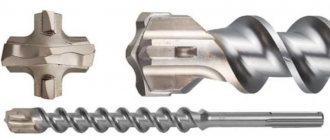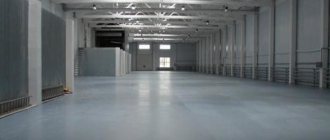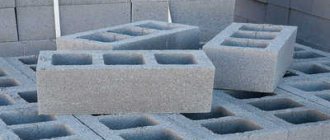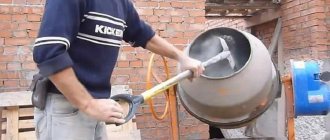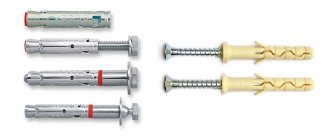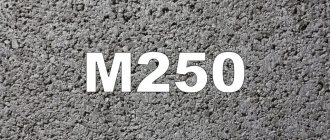In this short article I would like to talk about the basic properties and characteristics of concrete, its laying, setting time and other consumer qualities of this material, indispensable in construction. I would not like to grind water in a mortar and quote here encyclopedic data about concrete, which you could easily find in any article, which is copied from site to site in large quantities, and from a practical point of view is of little use. The terminology and text structure of such narratives can mislead even people who know the subject of the conversation. I once tried to glean some necessary information about concrete, but more often I came across either the cloth language of GOSTs, or
exercises. I, as a practicing builder, would like to talk about the most necessary things, and of course, I will try to do this in simple words: without the “conglomerate structure of stone-like materials in poured forms”
Quick section navigation:
- Concrete composition Main components and proportions. What is the concrete mixture made of?
- Strength of concrete Strength classes and grades. Samples, cubes, control.
- Workability of concrete Workability, cone slump, cast concrete.
- Frost resistance of concrete Frost resistance coefficient F.
- Water resistance of concrete Water resistance coefficient W.
- Hardening, hardening of concrete Setting times, winter concreting.
Composition of concrete.
Ready-mix concrete, also known as ready-mix concrete, is a rolling stock of four main components mixed in a certain proportion: cement, crushed stone, sand, water. A similar mixture, but without the use of crushed stone, is called cement mortar or sand concrete, although sand concrete uses sand of a larger fraction (fineness modulus). The weight ratio of the components for preparing a concrete mixture is approximately as follows: Cement - 1 part, Crushed stone 4 parts, Sand - 2 parts, Water - 1/2 part. For example: cement - 330 kg, crushed stone - 1250 kg, sand - 600 kg, water - 180 liters. Naturally, these figures are very approximate and in fact depend on many factors such as: the required grade of concrete, grade of cement, characteristics of crushed stone and sand, the use of plasticizers and other additives, etc. and so on. For example: when using m-400 cement, concrete with this composition will show grade m-250. With cement m-500, the grade of concrete will be already m-350. The numbers are relative! When producing concrete at a concrete plant, dozens of parameters and characteristics are taken into account.
Cement and water are the main components of concrete. Actually, they are entrusted with the main function - to connect all the components into a single monolithic structure. Maintaining the correct proportion of these two components (water-cement ratio) is the most important task in the production of concrete. It’s not just about the amount of water and cement introduced into concrete. With this, everything is simple. It is important to take into account all the nuances: the moisture content of crushed stone and sand, their moisture absorption, etc. and so on. Cement, interacting with water (cement hydration), is able to set and harden, forming the so-called cement stone. Many people have probably encountered this very stone when they uncorked a bag of cement that had been left lying in the barn since last summer. Well, what happens. Cement and water are their own stone. It’s as if it’s a completely self-sufficient material. But no. Cement stone becomes deformed when hardening. Volumetric shrinkage reaches 2 mm/m. It doesn’t seem like much, but due to the unevenness of these shrinkage processes, internal stresses arise and microcracks appear. These microcracks are practically invisible, but the strength and durability of the cement stone is reduced. In order to reduce these deformations, fillers are added to the composition:
Actually, they are entrusted with the main function - to connect all the components into a single monolithic structure. Maintaining the correct proportion of these two components (water-cement ratio) is the most important task in the production of concrete. It’s not just about the amount of water and cement introduced into concrete. With this, everything is simple. It is important to take into account all the nuances: the moisture content of crushed stone and sand, their moisture absorption, etc. and so on. Cement, interacting with water (cement hydration), is able to set and harden, forming the so-called cement stone. Many people have probably encountered this very stone when they uncorked a bag of cement that had been left lying in the barn since last summer. Well, what happens. Cement and water are their own stone. It’s as if it’s a completely self-sufficient material. But no. Cement stone becomes deformed when hardening. Volumetric shrinkage reaches 2 mm/m. It doesn’t seem like much, but due to the unevenness of these shrinkage processes, internal stresses arise and microcracks appear. These microcracks are practically invisible, but the strength and durability of the cement stone is reduced. In order to reduce these deformations, fillers are added to the composition:
- Coarse aggregates: crushed stone
- Fine aggregates: sand
The role of these aggregates is to create a structural frame that absorbs shrinkage stresses, and as a result, the finished concrete shrinks less. The strength and elastic modulus of concrete also increases (reducing structural deformations under load), and reduces creep (when concrete is irreversibly deformed under long-term loads). Aggregates significantly reduce the cost of concrete. After all, cement is much more expensive than crushed stone and sand.
At the beginning of the article, you read about the approximate proportions of the main components of the concrete mixture. Let's now convert the weight fractions into volume fractions and calculate:
- Cement 0.25 cubic meters (330 kg. Bulk density of cement on average 1300 kg per cubic meter)
- Water 0.18 cubic meters (180 liters. Liters, they are also liters in Africa)
- Crushed stone 0.9 cubic meters (1250 kg. With a bulk density of 1350 kg per cubic meter)
- Sand 0.43 cubic meters (600 kg. With a bulk density of 1400 kg/cubic.)
In total, if everything is laid out and poured into different containers, we will get a total volume of 1.76 cubic meters! How does all this fit into one cube of concrete? Just. Take a liter jar and fill it up to the neck with crushed stone. There will be a lot of free space between individual grains (intergranular voidness). And we fill this very emptiness with two glasses of sand, one glass of cement, and a glass of water, while shaking and stirring. And everything will fit! As a result of such manipulations, we obtain a completely dense substance. All pores are filled, all fillers rest against each other. If the concrete is not moved or touched, it begins to harden (solidify) quite quickly. When vibrating and mixing, the concrete returns to a plastic state. (thixotropy). As soon as you leave him behind, he will again begin to turn into a dense elastic mass.
Perhaps a few more lines about coarse aggregate (crushed stone).
The strength (grade) of crushed stone should be approximately 2 times greater than the calculated grade of concrete. This is done due to the fact that the design (28-day) grade of concrete is always significantly lower than its actual strength, which it will gain in six months or a year. The strength of crushed stone does not increase over time. So they are leveled out. In any case, all this is done in the form of a safety margin that is not standardized by design requirements. As they say - for every fireman. Here is a calculation from GOST 26633-91, about the ratio of the grade of crushed stone and the grade of concrete.
Very briefly about the main types of crushed stone.
- Limestone. Average strength (grade) 500-600. Certain types of limestone fillers (up to 800) are quite suitable for producing concrete up to the M-350 grade, but due to lower frost resistance, limestone is usually used for the production of concrete grades M-100 - M-300.
- Gravel. The strength of the main types of gravel (800-1000) is sufficient for the production of concrete grades up to M-450. (usually no higher than m-400) The most common type of filler. It has all the good qualities needed to produce most concrete mixtures. For a custom build I would choose this. Concrete on gravel is cheaper. For those grades of concrete that are used in private construction, the strength is more than sufficient. And the background radiation is less than that of granite.
- Granite. The most durable of the listed fillers. Among the additional advantages over the previous ones, it has higher rates (up to 1400 m), low water absorption and, as a result, increased frost resistance. For example, in the construction of roads, modern GOST standards allow the use of only granite crushed stone.
Of course, not everything is so simple with crushed stone. There are many more nuances that make their own adjustments: flakiness, % of grains of weak rocks, etc. and so on. But more about this some other time.
In all information materials, price lists, etc. concrete is indicated with a digital and letter index. Brand M-, class B-, mobility P-, water resistance W-, frost resistance F- must be indicated. Let's briefly talk about each of these parameters.
Microsilica
This is an amorphous powder of a microscopic fraction. It is introduced into the concrete composition along with a plasticizer. The purpose of its application is to fill the space between larger particles. As a result, porosity is reduced, density is increased, and water resistance is increased. The technology is used in the production of road surfaces, making them more durable when used in any adverse environment.
The use of microsilica without plasticizers does not make sense.
Strength, brand, class of concrete. Determination methods. Control samples.
The choice and purchase of a specific type and brand (class) of concrete mixture is determined by your project. If there is no project, then you can trust the recommendations of your builders. They can recommend concrete of a particular brand or class. If you have some doubts about the competence of your builders, you can try to figure it out yourself.
The numbers of the concrete grade (m-100, m-200, etc.) indicate (on average) the compressive strength in kgf/sq.cm. Compliance with the required parameters is checked by compression
cubes or cylinders cast from a sample of the mixture and kept for 28 days of normal hardening.
In modern projects, concrete is indicated in classes. In general, a concrete class is a parameter similar to a grade, but with minor nuances: grades use the average strength value, while grades use guaranteed strength with a coefficient of variation of 13%. However, this does not matter to you. I won’t fool you with strength variation coefficients and other technical nuances. The design documentation, if you have it, of course, should indicate what class of concrete should be used. In accordance with ST SEV 1406, all modern design requirements for concrete are specified in classes. I don’t know to what extent this is observed, because for some reason 90% of construction organizations order concrete in stamps :-).
The main thing for you is that the concrete brought to you matches the brand that you actually ordered. Of course you can check, but not right away. What's worth doing.
When unloading concrete, take a sample and cast a couple of cubes measuring 10x10x10 cm or 15x15x15 cm. To do this, you can put together special shapes of the required size from planks. Before pouring concrete into molds, it is advisable to moisten the boxes so that dry wood does not take a lot of moisture from the concrete, thereby negatively affecting the process of cement hydration. The poured mixture must be pierced with a piece of reinforcement or something similar: poke it into the mixture, like pounding mashed potatoes, so that unfilled spaces (shells) do not form in the poured sample, excess air comes out, and the mixture becomes denser. You can also compact the mixture by hitting the sides of the boxes with a hammer. Store the cast cubes at medium temperature (about 20 degrees) and high humidity (about 90%).
After 28 days, you can bring all this splendor to any independent laboratory with a clear conscience. They will suppress all this for you and give you a verdict - whether the concrete corresponds to the declared brand or does not correspond. However, it is not necessary to wait 28 days; for this, there are intermediate stages of hardening at the age of 3, 7, 14 days. During the first 7 days, concrete gains about 70% of its design strength (naturally, subject to normal temperature). In damp and cold seasons, the setting time of concrete and its hardening period increase significantly.
What nuances may arise when collecting and storing sample cubes:
- Do not dilute concrete with water in a concrete mixer truck.
- Take samples directly from the concrete mixer tray.
- Thoroughly compact the concrete mixture in the molds by bayoneting (mashed potatoes)
- Store samples in proper conditions: not in the sun or on the stove :-)) It is better in a cool basement, or just in the shade.
That's all about the cubes. If you suddenly forgot to take samples, but would like to know that everything is in order, contact an independent laboratory that can measure the strength on site. For this purpose, there are so-called non-destructive methods for studying strength: testing using shock pulse methods using a sclerometer. People call it tapping concrete. Ultrasonic and other methods for determining strength are also used.
Let's move on to other important parameters of concrete. Namely:
Search for new solutions
Not only the quality of the material plays a role in consumer demand. New technologies for concrete products are beginning to take on an innovative format. Here St. Petersburg again acted as the forefather. Well rings made of reinforced concrete almost immediately gained popularity in the market. The secret turned out to be in the shape of the ends, which had special locks. Connecting such rings is much faster and easier, and the quality of the connection is superior to traditional methods. Currently, many reinforced concrete structures with similar innovations are produced in Russia.
Kevlar concrete
The technology makes it possible to produce decorative and at the same time extremely durable products with a glossy surface. Artificial stone visually resembles marble, and with the use of pigments it can be presented in any color tones.
This concrete is reinforced with small fibers, in this case Kevlar, but the main essence of its production lies in the process. Mixing is carried out in gravity mixers with the alternate addition of all ingredients. The main point is the addition of water, the amount of which is strictly dosed. As a result, balls (pellets) measuring 2-5 cm are formed in the mixer, which exclude air in their composition. These balls are poured into the mold, and during the vibration process they fill it evenly, as if spreading throughout the entire volume.
In Russia, new technologies for concrete production are being introduced mainly in small enterprises, while in Europe this is considered a promising area.
Concrete of the future
Dutch scientists decided to create “eternal” concrete and they were very successful. Bacteria were introduced into the composition based on white cement, and calcium lactic acid was used as their food. Microorganisms readily eat it, producing limestone, which fills microcracks.
The second option for a material that has the ability to self-heal is elastic concrete. Its elasticity is achieved thanks to the group of minerals it contains, making it more resistant to dynamics. Reduction is achieved through its chemical reaction with carbon dioxide in the atmosphere. The reaction is activated by rainwater, and its product becomes calcium carbonate, which is the “chief doctor of concrete.”
The Canadians proposed an interesting option. Eco-concrete - the material received this name because of the production method, the main ingredient of which was carbon dioxide. Moreover, they took carbon dioxide from enterprises where it was obtained as a by-product. In other words, the production of such eco-concrete helps reduce the greenhouse effect.
Workability, mobility, cone settlement.
All these terms basically mean the same thing. The designation in the invoices and passports of the concrete mixture is in the form of the letter P with a coefficient from 1 to 5 (example: P-3) or as follows: cone settlement is 10-15 cm. For practical use, it is important to know the following: For standard monolithic work, mobility concrete P- 2 - P-3. When pouring densely reinforced structures, narrow formworks, columns and other similar narrow cavities that are difficult to fill with concrete, it is advisable to use concrete with mobility n-4 and higher (cone draft 16-21 cm). Such a concrete mixture may be called poured concrete. (in the era of developed socialism, cast concrete was considered to be concrete with a cone draft of 12 cm - slightly more than n-2) These types of concrete mixtures tolerate laying in formwork well, without the use of a vibrator. A similar mobility of concrete should be chosen if a concrete pump is used to lay the concrete mixture
There is also such a thing as concrete hardness. Indicated by the letters Zh1-Zh4. Basically, when they talk about hard concrete, they mean lean concrete, used mainly in road construction. It is characterized by a reduced content of water and cement. I won’t write about super-hard types. It is unlikely that you will need it.
To make pouring easier and in the absence of vibrators on site, foremen and builders often increase the mobility by diluting the concrete in a concrete mixer with water, which is absolutely not worth doing! Because the water-cement ratio is one of the key proportions on which the final strength of concrete directly depends. Moreover, even a slight dilution of the mixture with water can significantly reduce the strength by one or two grades. Concrete of the design grade m300, as a result of dilution with water, can easily show m100 m200.
An increase in the mobility of the concrete mixture to indicators P4, P5, and a cone slump of more than 16 cm is achieved exclusively through the use of plasticizer additives at the plant. This is the only way to obtain cast concrete intended for laying in formwork with a dense frame of reinforcement, or for monolithic work using a concrete pump. By diluting the concrete mixture with water, you will certainly deteriorate its quality.
Manufacturing proportions and strength gain of concrete mass
In order to produce a high-quality concrete mixture, it is necessary to take into account the purpose of the structure for which it is used. With a superficial approach to choosing the proportions of the mixture, you can get a very fragile material that is not suitable in terms of strength, water resistance, frost resistance or mobility. Or, on the contrary, get a high-class solution with high physical and mechanical properties, where this is not necessary. To produce concrete solutions that perform their functions, the following tables are used:
Composition and proportions of concrete from cement
Concrete does not acquire all its qualities in those 2-3 days when it already seems absolutely solid. In the first week after pouring, the mixture acquires 70% of its strength.
The material reaches brand strength on the 28th day after installation. At the same time, the strength gain does not stop after 28 days. Within three years after pouring, the structure can reach 300% relative strength at 28 days. He becomes very strong.
To estimate the rate at which concrete masses gain strength, use the following graph:
Concrete strength gain schedule
When building your own home, you can always hire specialists who will do everything for you at home. If you have some knowledge, you can always prepare lightweight concrete with your own hands or evaluate its quality without missing out on the details.
Frost resistance coefficient of concrete.
It is designated by the letter F with a number from 25 to 1000 and indicates the number of freezing-thawing cycles during which concrete retains its original strength characteristics (with acceptable deviations). What practical value does this parameter have for you? Well, in short, then: freeze-thaw cycles are transitions of a moisture-saturated concrete structure from a wet state to a frozen state and back.
What does this mean? Let's take a standard picture: moistening concrete structures using the example of capillary suction of moisture from the ground by the foundation of a house. Water, melting snow, wet soil, etc., fills the micropores of concrete according to a principle similar to the wick in a kerosene stove. Concrete here acts as an absorbent sponge. Then this water freezes in micropores, and when frozen, it expands, tearing apart everything that interferes with it. This is where changes in the structure of concrete occur: microcracks, etc. Moreover, next time, the water, having filled these microcracks and frozen, will tear them apart even more.
Of course, everything is not as scary as I described here, because foundations, as a rule, are protected by waterproofing, blind areas, and water repellents. Moistening does not occur so intensely, not over the entire thickness of the concrete, etc. But I would like you to more or less understand the nature of the process.
At concrete plants and concrete mixing units of various plants producing reinforced concrete products, tests of control samples are carried out in critical modes. The concrete cube is literally soaked in water (or a special solution) with full moisture saturation, and frozen at once to -18. And so on - with intermediate measurements, until the critical point is reached, namely, the loss of the design strength. The number of such water-ice cycles is the F coefficient. Foundations on moisture-saturated soils, bridge supports standing in water, and other hydraulic structures partially operate in this mode.
To increase frost resistance, concrete plants use various additives in concrete, for example air-entraining additives, etc. But frost resistance, increased by air-curing additives (exceeding the norm for this brand of concrete) reduces its strength. Found there, then lost. The best results in increasing frost resistance can be achieved by using hydrophobic or prestressing cement in mixing concrete. All main cycles occur in autumn and spring, when temperature changes occur every day from plus to minus and back. In conventional construction, the average frost resistance is F100-F200.
The next parameter of concrete that I would like to talk about is inextricably linked with frost resistance.
Cuboid crushed stone and sand
In the Russian Federation, the production of concrete with cube-shaped aggregates is a new product. The technology was first used in St. Petersburg. Due to its cubic shape, crushed stone forms a tight connection, reduces cement consumption and increases density. The first samples have proven themselves well in road construction.
The situation with cube-shaped sand is similar, but the pioneer was an enterprise in the Primorsky Territory. Today they have the only installation for the production of such sand, which was purchased in Japan.
By purpose
Modern concrete is used to build cottages and construct heavy elements of various structures (bridges, multi-story buildings, etc.). However, there are types of concrete that are not able to withstand heavy loads. There are special and ordinary types of material. Thus, builders resort to ordinary concrete when erecting monolithic structures, laying foundations, erecting columns, etc. There are also types of concrete on sale that are intended for finishing buildings inside and outside.
It is customary to resort to special concrete to create dams, road surfaces, car parks, and airports. These types of concrete are produced in different compositions and have different properties. This concrete is used for thermal insulation of premises. It has good thermal insulation characteristics, but at the same time is not very durable. There is a wide selection of finishing solutions on the market. Various rocks and stones are used as filler for building materials. In addition, experts have developed compositions with special characteristics (resistance to harmful chemicals, sound insulation, fire resistance, X-ray resistance, radiation protection, etc.).
Return to contents
Density
The ratio of mass to volume is the next indicator that is taken when choosing a material. Classification by concrete density according to GOST:
- Particularly light (spongy) with high porosity. Volumetric weight – up to 800 kg/m3. These are foam and aerated concrete;
- Lightweight with a density of 800-2000 kg/m3. These are pumice concrete, slag concrete, wood concrete and other materials based on a cement binder with light aggregates;
- Heavy concrete or ordinary. Their density is 2000-2500 kg/m3. This is a standard material for the basic construction of building structures and monolithic housing construction. Filler – crushed stone, gravel;
- Particularly heavy concrete contains filler from barite, metals and iron ores. The volumetric weight of such material exceeds 2500 kg/m3. Concrete is used in the construction of specific facilities where protection from radiation of various natures is necessary (laboratories, landfills, nuclear power plants).
Light and extra-light concretes have low density and high porosity and retain heat well indoors. Their use is possible without additional insulation.
Heavy and especially heavy concrete is durable. Their use makes it possible to build high-impact objects with a number of floors, of any configuration in different climatic conditions, which cannot be said about porous materials. True, stones on crushed stone and metal filler do not retain heat well - to avoid additional thermal insulation, you will have to install a very thick structure, which will require considerable expenses.
